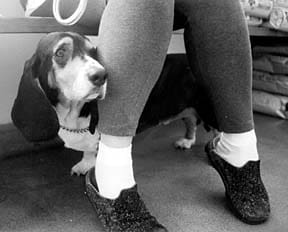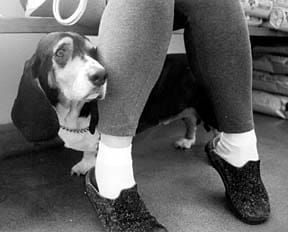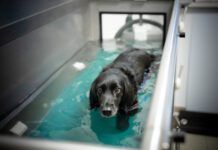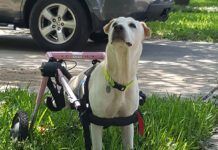I have two rescue Danes and I also assist with Great Dane rescue. Recently, I fostered a black, 2 1/2-year-old, neutered Dane. He had no biting history and is friendly with kids, people, and other dogs. The previous owner was honest and told me that the dog did not like the vet’s office, baths, or his feet to be handled.
I took the dog to a veterinary hospital and he did very well in the waiting room with the other dogs. I praised him and treated him for all his calm behavior. I explained to the veterinarian’s technician that the dog did not do well at the vet’s and that I had a soft muzzle that I would put on the dog. The dog clearly did not like it when the technician drew blood for a blood test, and he was clearly afraid:ears back and tail tucked under. I verbally corrected him when he growled, and when he was quiet I held a food treat in front of his muzzled face.
As luck would have it he had an ear infection and needed his ears flushed and treated. In my opinion, the vet really muscled this dog around, slamming him into a sit and shaking him by the scruff of the neck when he growled. When the dog was quiet she would praise him. She did let the dog smell the ear medicine before she used it on him, and she also warmed the cleansing solution. The dog was muzzled the entire time, which I thought was appropriate.

The vet did praise the dog and removed his muzzle when she was done, and even offered him a treat (which he declined to take). Then the vet, who knows me fairly well, told me I had to be more firm with the dog. I have a lot of respect for my vet, however, since this dog was a rescue dog, had been through a lot and was scared to death, I felt this treatment was too rough. The technician also stated that Danes were also known biters – is this true?
When I placed the dog with a new owner I told her all about the experience at the vet’s. The new owner and I put medication in one of the dog’s ears while I gave him food treats and he did well with no muzzle and no growling!
We gave these questions to Pat Miller, WDJ’s regular gentle training expert. Miller, a member of the Association of Pet Dog Trainers, offers private and group dog training classes from her base in Chattanooga, Tennessee.
First of all, kudos to you for the good work you do, both in Dane rescue and in spreading the word about the effectiveness of positive training methods. How unfortunate for your latest Rescue Guy (let’s call him RG) that he had to undergo such forceful treatment at the hands of your veterinarian.
You clearly have a long-term relationship with this vet, and many of the things you describe indicate that she goes out of her way to make her patients comfortable – warming the cleansing solution, for example. However, it sounds like she subscribes to the force/intimidation school of dog handling. She is not alone. Most veterinarians receive(d) little or no comprehensive training in dog behavior during their years of higher education. Many of them read the same books that lots of dog trainers and owners have read – William Koehler and Monks of New Skete – that encourage owners to punish their dogs for any signs of aggression (or self-defense, from the dog’s point of view!), such as growling or snapping. These ill-advised responses include the scruff shake, alpha roll, jerks on the collar, hitting, muscling the dog around, and the extremes of hanging and helicoptering (which are just exactly what they sound like). Fortunately this is changing, as more and more vet schools realize the value of veterinarians being more familiar with behavioral science in their practices.
To be fair, veterinarians have to get the job done. They must be able to handle a dog in order to examine and treat him. They should be willing to take a reasonable amount of time to help a dog relax, but should not be expected to take undue risks with their own personal safety or that of their staff, nor should we expect them to spend hours helping us socialize a stressed dog. That means we, as the dog’s caretakers, bear the threefold responsibility of:
• Preparing the dog for the veterinary visit
• Taking whatever precautions are necessary to ensure the safety of clinic staff
• and making sure our veterinarian is on the same philosophical page we are in regards to dog training and handling.
Counter conditioning and desensitization
What RG needs is some counter conditioning to change the way his brain responds to veterinary hospitals, baths, and attention to his feet. It would be helpful to take him to the vet hospital numerous times before his next examination and just sit with him in the waiting room, feeding him treats. Let clinic staff greet him and feed him treats. Don’t ask RG to do anything, and don’t even verbally correct him for growling. Just feed him lots of his super-favorite treats. Corrections for growling only add to his stress, confirming his belief that the vet hospital is a bad place to be.
Besides, the growl is an important tool for us. Dogs who are corrected for growling often learn to launch right into a bite without giving us that very useful warning that we are on thin ice. You want the dog to growl to let you know that he is being pushed to his limits so you can back off and reduce his stress, in order to prevent the bite.
Help RG’s new family understand the importance of doing counter conditioning and desensitization in relation to vet visits, baths, and foot handling so that he learns to accept these three important procedures. With each ritual, find a level of interaction that doesn’t unduly stress him (such as sitting in the clinic waiting room, sitting on the floor next to the bathtub, touching his knee, elbow, or shoulder). Expose him to that level of stimulus, and let the treats rain from the heavens. Do it every day, several times a day if possible, until his reaction changes from suspicion as you run the bath water or walk through the clinic door to eager anticipation. You are working to change his involuntary reflex to each of these situations from negative to positive (this is the counter conditioning part).
When he looks forward to this level of interaction, very gradually increase the stimulus. Move your hand from his elbow toward his knee. Take him from the waiting room into the exam room. Splash around in the tub water (this is the desensitization part). Move forward gradually with each stimulus, and pause at each new level until “treats raining down from the heavens” convinces him that this, too, is a wonderful thing. Herbal and homeopathic remedies, massage and TTouch techniques may also help him relax and enjoy the experiences. If at any time you provoke an aggressive reaction, you have advanced too quickly.
This takes time and a real commitment. RG has had more than two years to learn the behavior – it’s only fair to take a significant amount of time to change it. And it is important to do so. Once incident where he is pushed too far could mean a serious bite and the end of his life.
Proper use of muzzles
You did an excellent job of this by muzzling RG prior to subjecting him to an experience you knew he would react badly to. The muzzle is a very useful safety tool. Here are some tips on using muzzles:
• Condition your dog to enjoy his muzzle (or at least, feel OK about it) prior to using it in a stressful situation. Do this by associating the muzzle with treats. Show him the muzzle, feed him a treat. Let him sniff it, feed him a treat. If your dog knows how to “target” (see “Tricks for Clicks,” May 2000), use the muzzle as a target object and reward him for touching it with his nose. Slip it over his nose, slip it off, feed him a treat. Slip it over his nose, buckle it, unbuckle it, slip it off, feed him a treat.
Repeat each of these steps numerous timesbefore moving on to the next. Slip his muzzle on, slip it off, feed him his dinner. Slip it on, take him for a walk. You want him to associate his muzzle with wonderful things so it doesn’t stress him further to be muzzled at the vet hospital.
• Be sure the muzzle is comfortable and properly fitted. It shouldn’t bind, rub, restrict his breathing or his vision. Soft muzzles and basket muzzles are both acceptable, although I find that it’s easier to feed a dog treats when he is wearing a soft fabric muzzle, the kind that is open on the end.
• Protect your dog when he is muzzled. He is defenseless. It is your job to protect him from other dogs and from humans who might take advantage of his helplessness.
• Don’t leave the muzzle on for more than 10-15 minutes at a time, even less if it is hot and humid, or if you have a flat-nosed breed of dog like the Bulldog or Boston Terrier, who already has breathing challenges.
• If a muzzle isn’t sufficient to restrain the dog for examination and treatment, it is my preference to have the veterinarian administer a sedative or tranquilizer rather than traumatize the dog further through rough handling.
Communicate with your vet
It is important that your vet support your dog training and handling philosophies. Talk with her in advance, especially when you have a problem child like RG, so she knows what handling techniques you will and won’t accept. Reassure her that you will take necessary precautions to ensure her safety. But don’t be intimidated by the letters after her name. You pay her to look after the health of your dog. As long as she can do that safely, she should not reprimand or train your dog for you.
RG’s encounter with your veterinarian reinforced his already strong belief that vet hospitals are bad places. Every time this happens, it becomes harder to convince him otherwise. His reaction tells us that most of his past visits to vets were probably not pleasant. His new family needs to start on a program to change his mind right now.
The good news is that he is tolerant and responsive in other environments. His bad experience at the vet’s didn’t translate into resistance to treatment at home. He gets along with dogs, kids, and other people. He sounds like a basically stable dog who has made a few unfortunate associations with a few necessary procedures. If that is true, his basically stable nature bodes well for his reprogramming potential.
As for Danes being biters: All dogs can and will bite under certain circumstances. Great Danes were bred to guard, so they have a genetically programmed protective nature. That doesn’t mean they are unpredictable biters who attack without provocation. It means that given the right circumstances, when they feel that there is a threat to themselves, their pack (you!) or their home, they will defend. It is our job to socialize them well and thereby teach them that the average human is not a threat.
Keep up the good work with your rescue furkids. And stick to your positive training guns!






